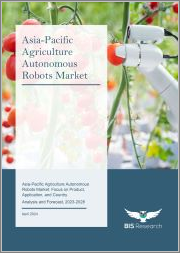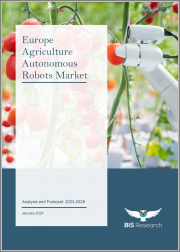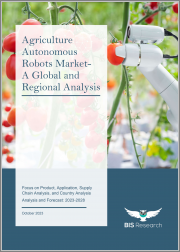
|
시장보고서
상품코드
1679213
석유 및 가스 로봇 시장 예측(-2030년) : 로봇 유형별, 컴포넌트별, 조작별, 용도별, 최종사용자별, 지역별 세계 분석Oil & Gas Robotics Market Forecasts to 2030 - Global Analysis By Robot Type, Component, Operation, Application, End User and By Geography |
||||||
Stratistics MRC에 따르면 세계의 석유 및 가스 로봇 시장은 2024년에 18억 2,000만 달러를 차지하며 예측 기간 중 CAGR 11.8%로 성장하며, 2030년에는 28억 2,000만 달러에 달할 것으로 예측됩니다.
석유-가스 로보틱스는 석유-가스 인프라의 탐사, 시추, 생산, 검사, 유지보수에 자동화 시스템, 로봇 기술, AI 구동 기계를 사용하는 것을 말합니다. 이러한 로봇은 심해 시추선, 파이프라인, 정유소 등 위험한 환경이나 원격지에서 작업을 수행하여 작업 효율성, 안전성, 정확성을 높입니다. 위험한 작업에 대한 인간의 개입을 줄임으로써 석유 및 가스 로봇은 위험을 최소화하고 비용을 절감하며 전체 에너지 부문의 생산성을 향상시킵니다.
북미 산업용 로봇 판매를 모니터링하는 A3(Association for Advancing Automation)에 따르면 2022년 기업이 주문한 로봇은 4만 4,196대로 2021년 대비 11% 증가했습니다.
증가하는 자동화 수요
자동화는 수작업에 대한 의존도를 줄이고 인적 오류를 최소화하며 탐사, 시추, 검사 및 정비 작업을 가속화하고 AI, IoT 및 머신러닝을 갖춘 로봇은 실시간 데이터 분석을 최적화하고 의사결정 및 생산성을 향상시킵니다. 기업이 안전성 향상, 운영 비용 절감, 지속가능성 향상을 목표로 하는 가운데, 자동화 프로세스에 로봇을 통합하는 것은 석유 및 가스 부문 시장 성장에 큰 도움이 될 것입니다.
기술적 과제와 복잡성
석유 및 가스 분야의 로봇은 극한의 온도, 고압, 부식성 환경과 같은 가혹한 작동 조건으로 인해 기술적 과제와 복잡성에 직면하고 있으며, 견고하고 내구성이 높은 로봇이 필요합니다. 심해, 좁은 공간, 폭발성 분위기에서 안정적으로 작동할 수 있는 로봇을 개발하는 것은 어렵습니다. 기업은 운영상의 위험, 높은 유지보수 필요성, 노후화된 인프라와의 통합의 어려움 등으로 인해 투자를 주저하고 보급이 늦어지고 있습니다.
해양 탐사 활동 증가
해양 탐사 활동의 활성화는 심해 및 초심해 작업의 효율성, 안전성 및 비용 효율성을 높여 석유 및 가스용 로봇에 대한 수요를 촉진합니다. 열악하고 외딴 해양 환경에서는 파이프라인 검사, 유지보수, 누출 감지 등의 복잡한 작업을 수행하기 위해 자율 수중 로봇(AUV), 원격 조종 차량(ROV), 로봇 시추 시스템이 필요합니다. 해양 탐사가 확대됨에 따라 로봇 공학의 채택이 가속화되어 시장 성장을 크게 촉진하고 있습니다.
레거시 시스템과의 통합 문제
석유 및 가스용 로봇은 노후화된 인프라, 호환되지 않는 소프트웨어, 표준화된 통신 프로토콜의 부족으로 인해 레거시 시스템과의 통합 문제에 직면해 있습니다. 많은 기존 시설에서는 수작업 프로세스나 노후화된 장비에 의존하고 있으므로 첨단 로봇을 원활하게 통합하는 데 어려움이 있습니다. 이는 도입 비용 증가, 맞춤형 적응의 필요성, 운영 중단을 유발하여 시장을 저해하고 있습니다.
COVID-19의 영향:
COVID-19는 석유 및 가스 로봇 시장에 큰 영향을 미쳤으며, 노동력 부족과 안전에 대한 우려로 인해 자동화가 가속화되었습니다. 그러나 기업은 원격 모니터링, 파이프라인 검사, 유지보수를 위해 로봇 공학에 투자하여 사람이 위험한 환경에 노출될 기회를 최소화했습니다. 유가 하락은 초기에는 투자를 둔화시켰지만, 비용 효율성, 안전 및 운영 탄력성을 추구하는 움직임은 업계에서 로봇 솔루션의 장기적인 채택을 촉진했습니다.
예측 기간 중 검사-감시-모니터링 분야가 가장 클 것으로 예상됩니다.
검사, 감시 및 모니터링 분야는 위험한 작업을 자동화함으로써 안전성, 효율성, 비용절감을 강화할 수 있으며, 예측 기간 중 가장 큰 시장 점유율을 차지할 것으로 예상됩니다. 드론, 크롤러, 자율 수중 로봇(AUV)과 같은 로봇은 AI, 적외선 이미지, 센서를 활용하여 누수, 부식, 구조적 약점 등을 실시간으로 감지하여 파이프라인, 해양 설비, 정유소 등을 검사하여 인간이 위험에 노출될 기회를 줄입니다.
예측 기간 중 석유화학 플랜트 분야는 가장 높은 CAGR을 나타낼 것으로 예상됩니다.
예측 기간 중 석유화학 플랜트 분야가 가장 높은 성장률을 나타낼 것으로 예상됩니다. 석유 및 가스 석유화학 플랜트에서 로봇은 검사, 유지보수, 누출 감지, 자재 취급, 유독성 가스 및 고온 등의 위험에 대한 인간의 노출을 줄일 수 있습니다. 자율형 드론, 로봇팔, 크롤러 로봇은 파이프라인 모니터링, 탱크 청소, 장비 진단에 사용됩니다. 로봇공학은 석유화학 산업에서 작업 효율성과 안전성을 향상시킵니다.
가장 큰 점유율을 차지하는 지역
예측 기간 중 아시아태평양은 업스트림, 중류, 하류 작업의 자동화 도입, 안전에 대한 우려, 효율성 향상에 대한 요구가 증가함에 따라 가장 큰 시장 점유율을 차지할 것으로 예상됩니다. 중국, 인도, 호주 등의 국가들은 생산성 향상과 인적 위험 감소를 위해 로봇 시추, 파이프라인 검사, 수중 탐사에 투자하고 있습니다. 자율 로봇과 AI 기반 분석의 발전은 이 분야에서 로봇의 채택을 더욱 촉진할 것으로 예상됩니다.
CAGR이 가장 높은 지역:
예측 기간 중 북미는 자동화, 안전에 대한 우려, 비용 효율성에 대한 요구가 증가함에 따라 가장 높은 CAGR을 보일 것으로 예상됩니다. 미국과 캐나다는 해양 및 육상 탐사 분야에서 선두를 달리고 있으며, 드론, 자율 수중 로봇(AUV), 로봇 암을 검사, 유지보수, 파이프라인 모니터링에 활용하고 있습니다. 에너지 효율과 기술 혁신에 대한 정부의 지원은 시장 성장을 더욱 촉진할 것입니다.
무료 커스터마이징 제공:
이 보고서를 구독하는 고객은 다음과 같은 무료 맞춤화 옵션 중 하나를 이용할 수 있습니다.
- 기업소개
- 추가 시장 기업의 종합 프로파일링(최대 3사)
- 주요 기업의 SWOT 분석(최대 3사)
- 지역 세분화
- 고객의 관심에 따른 주요 국가별 시장 추정, 예측, CAGR(주: 타당성 확인에 따라 다름)
- 경쟁사 벤치마킹
- 제품 포트폴리오, 지역적 입지, 전략적 제휴에 기반한 주요 기업의 벤치마킹
목차
제1장 개요
제2장 서문
- 개요
- 이해관계자
- 조사 범위
- 조사 방법
- 데이터 마이닝
- 데이터 분석
- 데이터 검증
- 조사 어프로치
- 조사 정보원
- 1차 조사 정보원
- 2차 조사 정보원
- 전제조건
제3장 시장 동향 분석
- 촉진요인
- 억제요인
- 기회
- 위협
- 용도 분석
- 최종사용자 분석
- 신흥 시장
- COVID-19의 영향
제4장 Porter's Five Forces 분석
- 공급 기업의 교섭력
- 바이어의 교섭력
- 대체품의 위협
- 신규 진출업체의 위협
- 경쟁 기업 간 경쟁 관계
제5장 세계의 석유 및 가스 로봇 시장 : 로봇 유형별
- 원격 조작형 무인 탐사기(ROV)
- 자율형 수중 탐사기(AUV)
- 무인항공기(UAV)
- 무인지상차량(UGV)
- 검사 로봇
- 협동 로봇(코봇)
- 기타 로봇 유형
제6장 세계의 석유 및 가스 로봇 시장 : 컴포넌트별
- 하드웨어
- 센서
- 액추에이터
- 카메라
- 컨트롤러
- 전력 시스템
- 소프트웨어
- 인공지능과 기계학습 알고리즘
- 데이터 처리와 분석
- 서비스
- 통합과 배포
- 정비와 지원
제7장 세계의 석유 및 가스 로봇 시장 : 조작별
- 자율 로봇
- 반자율 로봇
- 원격 조작 로봇
제8장 세계의 석유 및 가스 로봇 시장 : 용도별
- 검사, 감시, 감시
- 정비와 수리
- 파이프와 탱크 청소
- 자재관리
- 용접과 절단
- 해저 작업
- 굴착 지원
- 해체
- 기타 용도
제9장 세계의 석유 및 가스 로봇 시장 : 최종사용자별
- 정유소
- 석유화학 플랜트
- 배급 회사
- 유전 서비스 프로바이더
- 기타 최종사용자
제10장 세계의 석유 및 가스 로봇 시장 : 지역별
- 북미
- 미국
- 캐나다
- 멕시코
- 유럽
- 독일
- 영국
- 이탈리아
- 프랑스
- 스페인
- 기타 유럽
- 아시아태평양
- 일본
- 중국
- 인도
- 호주
- 뉴질랜드
- 한국
- 기타 아시아태평양
- 남미
- 아르헨티나
- 브라질
- 칠레
- 기타 남미
- 중동 및 아프리카
- 사우디아라비아
- 아랍에미리트
- 카타르
- 남아프리카공화국
- 기타 중동 및 아프리카
제11장 주요 발전
- 계약, 파트너십, 협업, 합병사업
- 인수와 합병
- 신제품 발매
- 사업 확대
- 기타 주요 전략
제12장 기업 프로파일링
- Baker Hughes
- Chevron
- Equinor
- ExxonMobil
- Kawasaki Heavy Industries
- ABB
- Siemens
- TotalEnergies
- Shell
- Sekal AS
- Yaskawa Electric Corporation
- Fanuc Corporation
- Rockwell Automation
- Cognex Corporation
- KION Group
- Intuitive Surgical
- iRobot Corporation
- Boston Dynamics
- Repsol
- Saudi Aramco
According to Stratistics MRC, the Global Oil & Gas Robotics Market is accounted for $1.82 billion in 2024 and is expected to reach $2.82 billion by 2030 growing at a CAGR of 11.8% during the forecast period. Oil & Gas Robotics refers to the use of automated systems, robotic technologies, and AI-driven machines in the exploration, drilling, production, inspection, and maintenance of oil and gas infrastructure. These robots enhance operational efficiency, safety, and precision by performing tasks in hazardous or remote environments, such as deep-sea rigs, pipelines, and refineries. By reducing human intervention in dangerous tasks, oil and gas robotics help minimize risks, lower costs, and improve overall productivity in the energy sector.
According to the Association for Advancing Automation (A3), which monitors industrial robot sales in North America, companies ordered 44,196 robots in 2022, 11% more than in 2021.
Market Dynamics:
Driver:
Growing demand for automation
Automation reduces reliance on manual labor, minimizes human error, and accelerates operations in exploration, drilling, inspection, and maintenance. Robots equipped with AI, IoT, and machine learning optimize real-time data analysis, improving decision-making and productivity. As companies seek to enhance safety, reduce operational costs, and improve sustainability, the integration of robotics in automated processes significantly propels market growth in the oil & gas sector.
Restraint:
Technical challenges & complexity
Oil & gas robotics face technical challenges and complexity due to harsh operating conditions like extreme temperatures, high pressure, and corrosive environments, requiring rugged, highly durable robots. Developing robots that can function reliably in deepwater, confined spaces, and explosive atmospheres is difficult. Companies hesitate to invest due to operational risks, high maintenance needs, and integration difficulties with aging infrastructure, slowing widespread deployment.
Opportunity:
Rising offshore exploration activities
Rising offshore exploration activities drive the demand for oil & gas robotics by enhancing efficiency, safety, and cost-effectiveness in deepwater and ultra-deepwater operations. Harsh and remote offshore environments require autonomous underwater vehicles (AUVs), remotely operated vehicles (ROVs), and robotic drilling systems to perform complex tasks like pipeline inspection, maintenance, and leak detection. As offshore exploration expands, the adoption of robotics accelerates, boosting market growth significantly.
Threat:
Integration issues with legacy systems
Oil & Gas robotics face integration issues with legacy systems due to outdated infrastructure, incompatible software, and lack of standardized communication protocols. Many existing facilities rely on manual processes and aging equipment, making it difficult to seamlessly integrate advanced robotics. This hampers the market by increasing deployment costs, requiring custom adaptations, and causing operational disruptions.
Covid-19 Impact:
The covid-19 pandemic significantly impacted the oil & gas robotics market, accelerating automation due to workforce shortages and safety concerns. However, companies invested in robotics for remote monitoring, pipeline inspection, and maintenance, minimizing human exposure in hazardous environments. Declining oil prices initially slowed investments, but the push for cost efficiency, safety, and operational resilience drove long-term adoption of robotic solutions in the industry.
The inspection, monitoring & surveillance segment is expected to be the largest during the forecast period
The inspection, monitoring & surveillance segment is expected to account for the largest market share during the forecast period owing to its enhanced safety, efficiency, and cost savings by automating hazardous tasks. Robots like drones, crawlers, and autonomous underwater vehicles (AUVs) inspect pipelines, offshore rigs, and refineries, reducing human exposure to risks. They use AI, thermal imaging, and sensors to detect leaks, corrosion, and structural weaknesses in real time.
The petrochemical plants segment is expected to have the highest CAGR during the forecast period
Over the forecast period, the petrochemical plants segment is predicted to witness the highest growth rate. Oil & Gas Robotics in petrochemical plants perform inspection, maintenance, leak detection, and material handling, reducing human exposure to risks like toxic gases and high temperatures. Autonomous drones, robotic arms, and crawler robots are used for pipeline monitoring, tank cleaning, and equipment diagnostics. Robotics drive operational efficiency and safety advancements in petrochemical industries.
Region with largest share:
During the forecast period, the Asia Pacific region is expected to hold the largest market share due to rising automation adoption, safety concerns, and efficiency demands in upstream, midstream, and downstream operations. Countries like China, India, and Australia are investing in robotic drilling, pipeline inspection, and underwater exploration to enhance productivity and reduce human risk. Advancements in autonomous robots and AI-driven analytics are expected to drive further adoption in the region.
Region with highest CAGR:
Over the forecast period, the North America region is anticipated to exhibit the highest CAGR due to rising automation, safety concerns, and cost-efficiency demands. The U.S. and Canada lead in offshore and onshore exploration, adopting drones, autonomous underwater vehicles (AUVs), and robotic arms for inspections, maintenance, and pipeline monitoring. Government support for energy efficiency and technological innovation further drives market growth.
Key players in the market
Some of the key players in Oil & Gas Robotics market include Baker Hughes, Chevron, Equinor, ExxonMobil, Kawasaki Heavy Industries, ABB, Siemens, TotalEnergies, Shell, Sekal AS, Yaskawa Electric Corporation, Fanuc Corporation, Rockwell Automation, Cognex Corporation, KION Group, Intuitive Surgical, iRobot Corporation, Boston Dynamics, Repsol and Saudi Aramco.
Key Developments:
In October 2024, Rockwell Automation unveiled innovative solutions at ADIPEC 2024, focusing on automation, AI, and robotics to assist the energy sector in reducing its carbon footprint, improving safety, and enhancing operational efficiency.
In August 2024, Chevron announced that it has begun deploying submersible robots for tank inspections at several U.S. refineries. These robots, equipped with high-definition cameras and advanced sensors, enhance safety by reducing the need for human entry into hazardous environments and provide superior data for evaluating tank integrity.
Robot Types Covered:
- Remotely Operated Vehicles (ROVs)
- Autonomous Underwater Vehicles (AUVs)
- Unmanned Aerial Vehicles (UAVs)
- Unmanned Ground Vehicles (UGVs)
- Inspection Robots
- Collaborative Robots (Cobots)
- Other Robot Types
Components Covered:
- Hardware
- Software
- Services
Operations Covered:
- Autonomous Robotics
- Semi-Autonomous Robotics
- Remote-Controlled Robotics
Applications Covered:
- Inspection, Monitoring & Surveillance
- Maintenance & Repair
- Pipe & Tank Cleaning
- Material Handling
- Welding & Cutting
- Subsea Operations
- Drilling Support
- Decommissioning
- Other Applications
End Users Covered:
- Refineries
- Petrochemical Plants
- Distribution Companies
- Oilfield Service Providers
- Other End Users
Regions Covered:
- North America
- US
- Canada
- Mexico
- Europe
- Germany
- UK
- Italy
- France
- Spain
- Rest of Europe
- Asia Pacific
- Japan
- China
- India
- Australia
- New Zealand
- South Korea
- Rest of Asia Pacific
- South America
- Argentina
- Brazil
- Chile
- Rest of South America
- Middle East & Africa
- Saudi Arabia
- UAE
- Qatar
- South Africa
- Rest of Middle East & Africa
What our report offers:
- Market share assessments for the regional and country-level segments
- Strategic recommendations for the new entrants
- Covers Market data for the years 2022, 2023, 2024, 2026, and 2030
- Market Trends (Drivers, Constraints, Opportunities, Threats, Challenges, Investment Opportunities, and recommendations)
- Strategic recommendations in key business segments based on the market estimations
- Competitive landscaping mapping the key common trends
- Company profiling with detailed strategies, financials, and recent developments
- Supply chain trends mapping the latest technological advancements
Free Customization Offerings:
All the customers of this report will be entitled to receive one of the following free customization options:
- Company Profiling
- Comprehensive profiling of additional market players (up to 3)
- SWOT Analysis of key players (up to 3)
- Regional Segmentation
- Market estimations, Forecasts and CAGR of any prominent country as per the client's interest (Note: Depends on feasibility check)
- Competitive Benchmarking
- Benchmarking of key players based on product portfolio, geographical presence, and strategic alliances
Table of Contents
1 Executive Summary
2 Preface
- 2.1 Abstract
- 2.2 Stake Holders
- 2.3 Research Scope
- 2.4 Research Methodology
- 2.4.1 Data Mining
- 2.4.2 Data Analysis
- 2.4.3 Data Validation
- 2.4.4 Research Approach
- 2.5 Research Sources
- 2.5.1 Primary Research Sources
- 2.5.2 Secondary Research Sources
- 2.5.3 Assumptions
3 Market Trend Analysis
- 3.1 Introduction
- 3.2 Drivers
- 3.3 Restraints
- 3.4 Opportunities
- 3.5 Threats
- 3.6 Application Analysis
- 3.7 End User Analysis
- 3.8 Emerging Markets
- 3.9 Impact of Covid-19
4 Porters Five Force Analysis
- 4.1 Bargaining power of suppliers
- 4.2 Bargaining power of buyers
- 4.3 Threat of substitutes
- 4.4 Threat of new entrants
- 4.5 Competitive rivalry
5 Global Oil & Gas Robotics Market, By Robot Type
- 5.1 Introduction
- 5.2 Remotely Operated Vehicles (ROVs)
- 5.3 Autonomous Underwater Vehicles (AUVs)
- 5.4 Unmanned Aerial Vehicles (UAVs)
- 5.5 Unmanned Ground Vehicles (UGVs)
- 5.6 Inspection Robots
- 5.7 Collaborative Robots (Cobots)
- 5.8 Other Robot Types
6 Global Oil & Gas Robotics Market, By Component
- 6.1 Introduction
- 6.2 Hardware
- 6.2.1 Sensors
- 6.2.2 Actuators
- 6.2.3 Cameras
- 6.2.4 Controllers
- 6.2.5 Power Systems
- 6.3 Software
- 6.3.1 Artificial Intelligence & Machine Learning Algorithms
- 6.3.2 Data Processing & Analytics
- 6.4 Services
- 6.4.1 Integration & Deployment
- 6.4.2 Maintenance & Support
7 Global Oil & Gas Robotics Market, By Operation
- 7.1 Introduction
- 7.2 Autonomous Robotics
- 7.3 Semi-Autonomous Robotics
- 7.4 Remote-Controlled Robotics
8 Global Oil & Gas Robotics Market, By Application
- 8.1 Introduction
- 8.2 Inspection, Monitoring & Surveillance
- 8.3 Maintenance & Repair
- 8.4 Pipe & Tank Cleaning
- 8.5 Material Handling
- 8.6 Welding & Cutting
- 8.7 Subsea Operations
- 8.8 Drilling Support
- 8.9 Decommissioning
- 8.10 Other Applications
9 Global Oil & Gas Robotics Market, By End User
- 9.1 Introduction
- 9.2 Refineries
- 9.3 Petrochemical Plants
- 9.4 Distribution Companies
- 9.5 Oilfield Service Providers
- 9.6 Other End Users
10 Global Oil & Gas Robotics Market, By Geography
- 10.1 Introduction
- 10.2 North America
- 10.2.1 US
- 10.2.2 Canada
- 10.2.3 Mexico
- 10.3 Europe
- 10.3.1 Germany
- 10.3.2 UK
- 10.3.3 Italy
- 10.3.4 France
- 10.3.5 Spain
- 10.3.10 Rest of Europe
- 10.4 Asia Pacific
- 10.4.1 Japan
- 10.4.2 China
- 10.4.3 India
- 10.4.4 Australia
- 10.4.5 New Zealand
- 10.4.10 South Korea
- 10.4.7 Rest of Asia Pacific
- 10.5 South America
- 10.5.1 Argentina
- 10.5.2 Brazil
- 10.5.3 Chile
- 10.5.4 Rest of South America
- 10.1 Middle East & Africa
- 10.10.1 Saudi Arabia
- 10.10.2 UAE
- 10.10.3 Qatar
- 10.10.4 South Africa
- 10.10.5 Rest of Middle East & Africa
11 Key Developments
- 11.1 Agreements, Partnerships, Collaborations and Joint Ventures
- 11.2 Acquisitions & Mergers
- 11.3 New Product Launch
- 11.4 Expansions
- 11.5 Other Key Strategies
12 Company Profiling
- 12.1 Baker Hughes
- 12.2 Chevron
- 12.3 Equinor
- 12.4 ExxonMobil
- 12.5 Kawasaki Heavy Industries
- 12.6 ABB
- 12.7 Siemens
- 12.8 TotalEnergies
- 12.9 Shell
- 12.10 Sekal AS
- 12.11 Yaskawa Electric Corporation
- 12.12 Fanuc Corporation
- 12.13 Rockwell Automation
- 12.14 Cognex Corporation
- 12.15 KION Group
- 12.16 Intuitive Surgical
- 12.17 iRobot Corporation
- 12.18 Boston Dynamics
- 12.19 Repsol
- 12.20 Saudi Aramco















